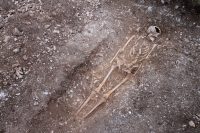 The skeleton of a man from the late Anglo-Saxon period has been discovered during an archaeological survey along the cable route of the Rampion Offshore Wind Farm in the South Downs region off the coast of Sussex. Archaeology South East were contracted by European electric company E.ON to excavate the installation path of the cable that will carry the wind farm’s power and have so far unearthed archaeological material — flint tools, pottery, evidence of cultivation — dating from the late Neolothic to the Bronze Age, Roman era, Middle Ages and the post-medieval period. The complete skeleton interred in a grave hewn from the chalk bedrock South Downs is famed for is the most exceptional of these finds.
The skeleton of a man from the late Anglo-Saxon period has been discovered during an archaeological survey along the cable route of the Rampion Offshore Wind Farm in the South Downs region off the coast of Sussex. Archaeology South East were contracted by European electric company E.ON to excavate the installation path of the cable that will carry the wind farm’s power and have so far unearthed archaeological material — flint tools, pottery, evidence of cultivation — dating from the late Neolothic to the Bronze Age, Roman era, Middle Ages and the post-medieval period. The complete skeleton interred in a grave hewn from the chalk bedrock South Downs is famed for is the most exceptional of these finds.
The skeletal remains of the adult male were found in 2015 on Truleigh Hill near Shoreham, West Sussex. Osteological analysis indicates he was between 25 and 35 years old when he died and likely lived a hard life up until then. There is evidence of a healed fracture on his left arm and repetitive stress on the vertebrae caused by bending or twisting movements. The skeleton was intact, missing only a few small bones from the hands and feet. There is no evidence of a coffin. He was placed in the grave on his back with his arms at his side in the east-west alignment typical of Christian burials.
Bone analysis put the date of his death between 1010 and 1023, while cuts to the neck pointed to a violent end. […]
Jim Stevenson, Project Manager for Archaeology South East, said: “Radiocarbon dating has revealed that the skeleton is most likely to be an execution burial of the later Anglo Saxon period.
“Most significantly two cut marks made by a sharp blade or knife were found at the mid length of the neck, which would have proved fatal.”
The grave site was located in an area known to have prehistoric graves. Apparently there were once burial mounds visible, but they were excavated flat in the 18th and 19th centuries and the digs were poorly documented so it’s not possible to pinpoint their location today. Isolated burials were sometimes found near the mounds. Perhaps this fellow having been condemned to death was denied access to a Christian cemetery and buried at an ancient holy site instead.
Hét se cyning hine beheáfdod? :skull:
Though, I wonder what makes this gentleman particularly “Saxon” or “Anglish”. I mean, he could have been a ‘beheáfdod’ local, possibly from the Neolothic, couldn’t he? He could be from elsewhere. And maybe that ‘ancient holy site’ had simply been converted to a plain old ‘execution site’.
However, does this even appear to be a complete decapitation? Do those cut marks on the (bottom of the?) vertebra -from the ‘mid length of the neck’- possibly indicate a ‘frontal’ blow? What about the ‘repetitive stress’ and his ‘bending or twisting’ movements? :confused:
As I now reach 40 I realize that when your time comes, you can’t cheat death, and somebody will find you 1000 years later buried in the ground.